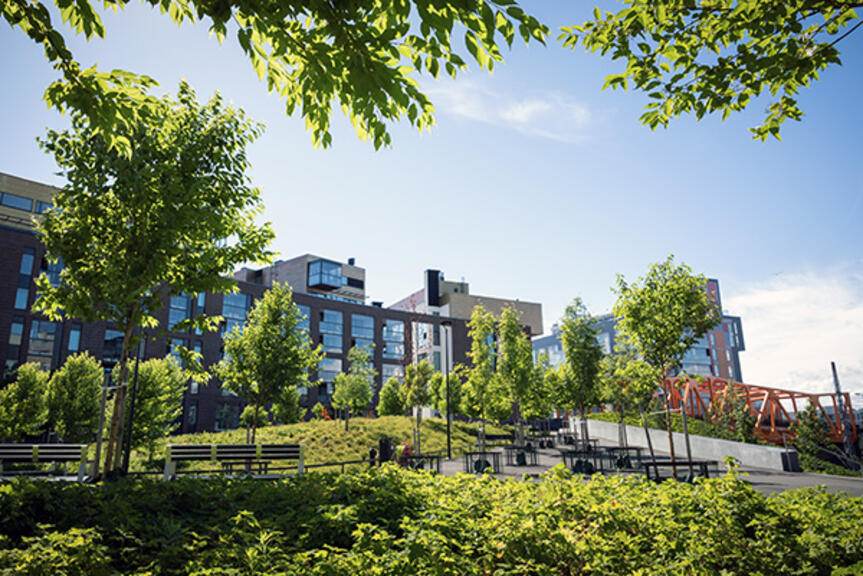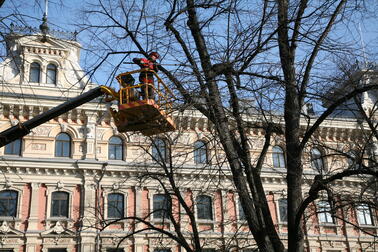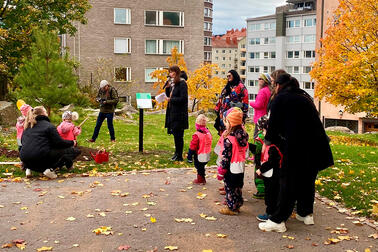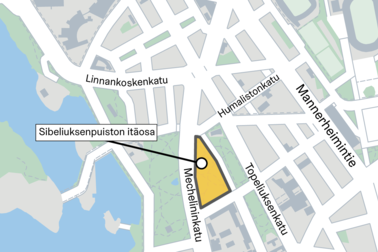
Jätkäsaari district’s Hyväntoivonpuisto Park will have a longer life than the buildings surrounding it, the landscape architects who designed it estimate. It will eventually grow into a five-hectare forest. Hyväntoivonpuisto Park is often compared with Kaivopuisto, and the parks are actually equal in size.
Hyväntoivonpuisto is the latest park area in the city centre area. The five-hectare area is sometimes compared with Kaivopuisto as the parks are equal in terms of their size. Put side-by-side with the age-old trees in Kaivopuisto, however, the saplings in Hyväntoivonpuisto may seem rather unimpressive.
Petra
Rantalainen, City of Helsinki’s project manager for park and green area planning, promises that patience will be rewarded. The young saplings simply need some time.
“Hyväntoivonpuisto holds quite a lot of trees and even fairly large saplings, but they are certainly small when compared to trees that are over a century old,” Rantalainen explains.
In twenty years, the park will have a very forest-like look and feel. As such, VSU Landscape Architects, which was involved in the design of the park, has stated that the park will have a longer life than the buildings that surround it.
Area of demanding conditions
Inspiration was sought from history in the design of Hyväntoivonpuisto Park. For example, old maps served as the inspiration for the blue cycling route: now the designers want to see a stream of people on the path that resembles a river.
That being said, the stories of the past have had to come face-to-face with modern challenges, as the waste station below the park and the differences in elevation had to be considered in Hyväntoivonpuisto’s design. Fortunately, growing medium abounds: with the exception of the thinner patch above the Airut parking garage, the park features 1.8 metres of load-bearing soil suitable for plants and trees.
“Designing the greenery for the park was a multistep process. The selection of plants and trees is steered by the City of Helsinki’s guideliens, in addition to which plant specialists and maintenance personnel are always listened to in the design of each area,” Rantalainen says.
She knows that the residents in the area have expressed wishes for flowering trees as well as various fruit trees and berry bushes. The northern section of Hyväntoivonpuisto Park, which is already available to the public, features plenty of trees.
The section that will be constructed later to balance the more forest-like area will focus on other types of plant file – the aim was to include varying landscapes in the park, which spans more than a kilometre, and a diverse range of species is essential to the park’s well-being.
More than a hundred pines
You can spot at least twenty different tree species in Hyväntoivonpuisto, which boasts hundreds and hundreds of trees in total. The list of species includes American basswood, bird cherry and Norway maple. For a park in the city centre area, Hyväntoivonpuisto also features an exceptionally large number of coniferous trees, as more than a hundred pines have been planted in it.
Arborist Sami
Kiema, who heads Stara’s green area efforts, predicts that coniferous trees will gain an increasing presence in the cityscape in years to come.
“Their use dwindled in the past as acid rain and urban emissions turned the needles brown and made them fall off,” Kiema explains.
In recent years, the main threat to the park’s trees has been posed by the urbanised rabbits and hares that have used snow drifts to gain access to the crab apple trees to munch on their bark to their hearts’ content. For this reason, investments in winter protection have been necessary.
The diversity in species aims to combat hazards larger than rabbits, however. Due to climate change and the international mobility of people and goods, the trees in Helsinki are threatened by an entirely new range of diseases and pests.
Kiema describes that a microbe destroyed the horse chestnut trees in Tokoinranta a few years ago. There is a constant stream of news from the world about new plant diseases that may potentially risk the entire local ecosystem.
“The wider the range of species, the better equipped the trees are to withstand a variety of threats, such as drought, diseases or pests,” Kiema says in summary.
Protection and pruning
According to Petra Rantalainen, the saplings have adapted well to the park.
“The number of tree deaths has been lower than average in Hyväntoivonpuisto, even though it would be normal in the early stages. The planted saplings have fared extremely well.”
For the first two years after completion, the park will be covered by the constructor’s maintenance guarantee, after which the responsibilities will be assumed by Stara’s green area maintenance personnel. For the first years, the trees will be allowed to recover from the shock of the transplantation into a new environment. For the first 2–3 growth seasons, the trees will not be pruned. During this period, the main thing is to ensure that the trees get enough water and stay healthy. Supporting the saplings is also important, especially in a windy area such as Jätkäsaari.
Once the initial period is over, it is time for the more long-term tree care project, i.e. structural pruning. In urban environments, trees do not need to compete in the same way as in forests where thousands of saplings may grow within a single hectare. In cities, it is the people’s responsibility to ensure enough space near the ground alongside pathways by removing overgrown branches which may otherwise be damaged.
“Structural pruning is controlled and regular pruning, which takes place over decades. If a park worker begins working in a specific area at twenty, they may continue pruning the very same trees until retirement age,” Kiema says.
Award-winning park
In 2020, Hyväntoivonpuisto Park was awarded as the Environmental Structure of the Year. The park, which has also been referred to as the heart of Jätkäsaari, has found its place not only as a through route but especially as a meeting place during the coronavirus crisis.
According to Sami Kiema, the largest amount of customer feedback concerns the full rubbish bins and littering. That said, Hyväntoivonpuisto features three vacuum waste collection points. No other park in the city centre has them.
Besides the above, the park naturally has plenty of other things to see and experience: the unique bridges and artistic support wall are part of the new district’s identity. The park is also used for studying the impact of biocarbon-based substrates on tree growth. The construction of the area is still under way, so more space for children will be added with the completion of the larger play park in the south section.
*^*^*^*^*^*^*^*^*^*^*^*
FACT: Numerous tree species grow in Hyväntoivonpuisto Park
- Norway maple
- Pine (more than 100)
- Rowan
- Small-leaved lime
- Bird cherry
- Ash
- Common oak
- Purple crab apple
- American mountain ash
- American basswood
- Large-leaved lime
- Bay willow
- Wych elm
- Manchurian cherry
- Common oak
- Common alder
*^*^*^*^*^*^*^*^*^*^*^*
Text:
Milla Palkoaho
Article photo: Hyväntoivonpuisto Park is already verdant, but in about
twenty years, it will have a very forest-like look and feel. Photo: Antti
Pulkkinen
The article was originally published in the Jätkäsaari-Ruoholahti newspaper
on 15 April 2021.


